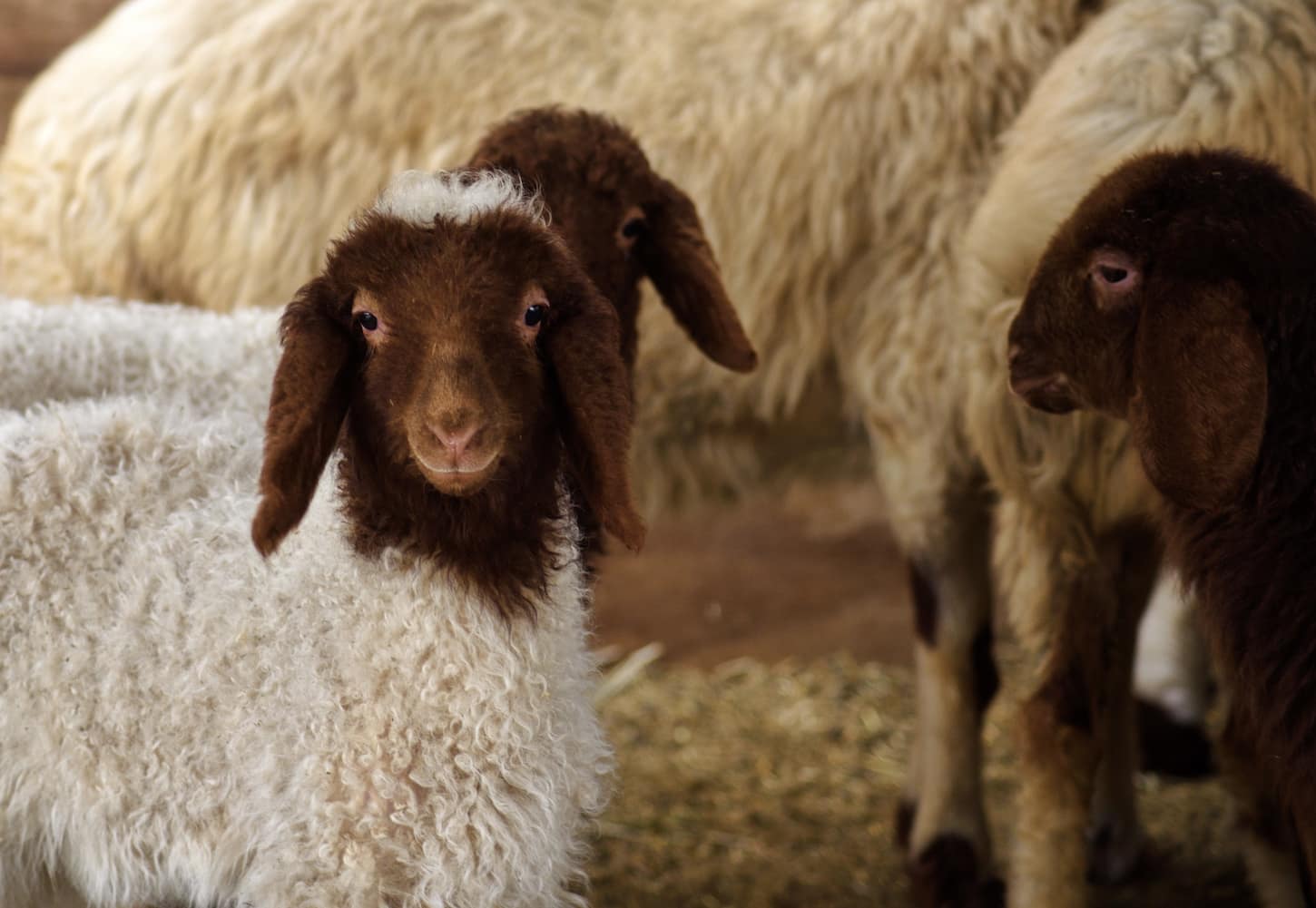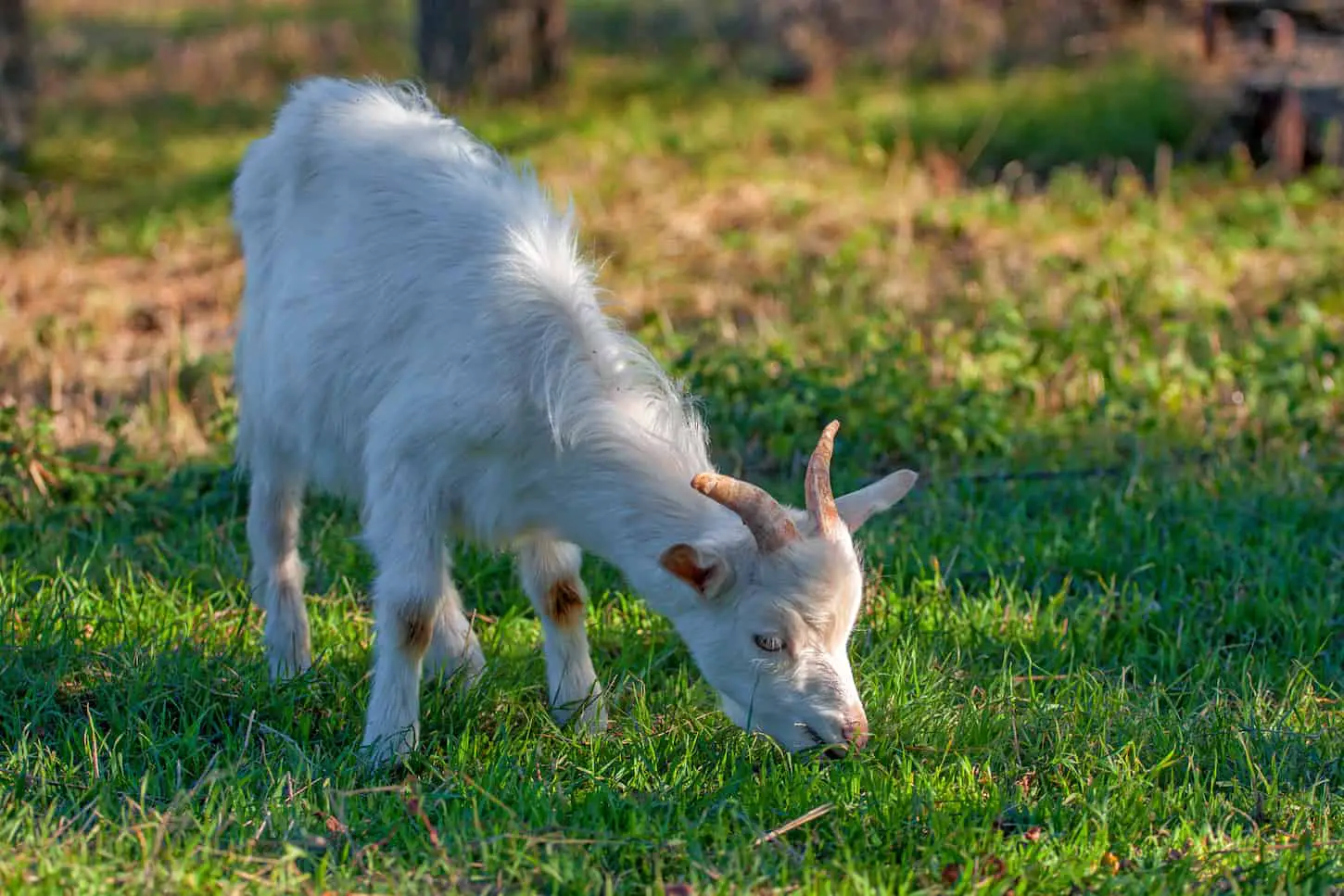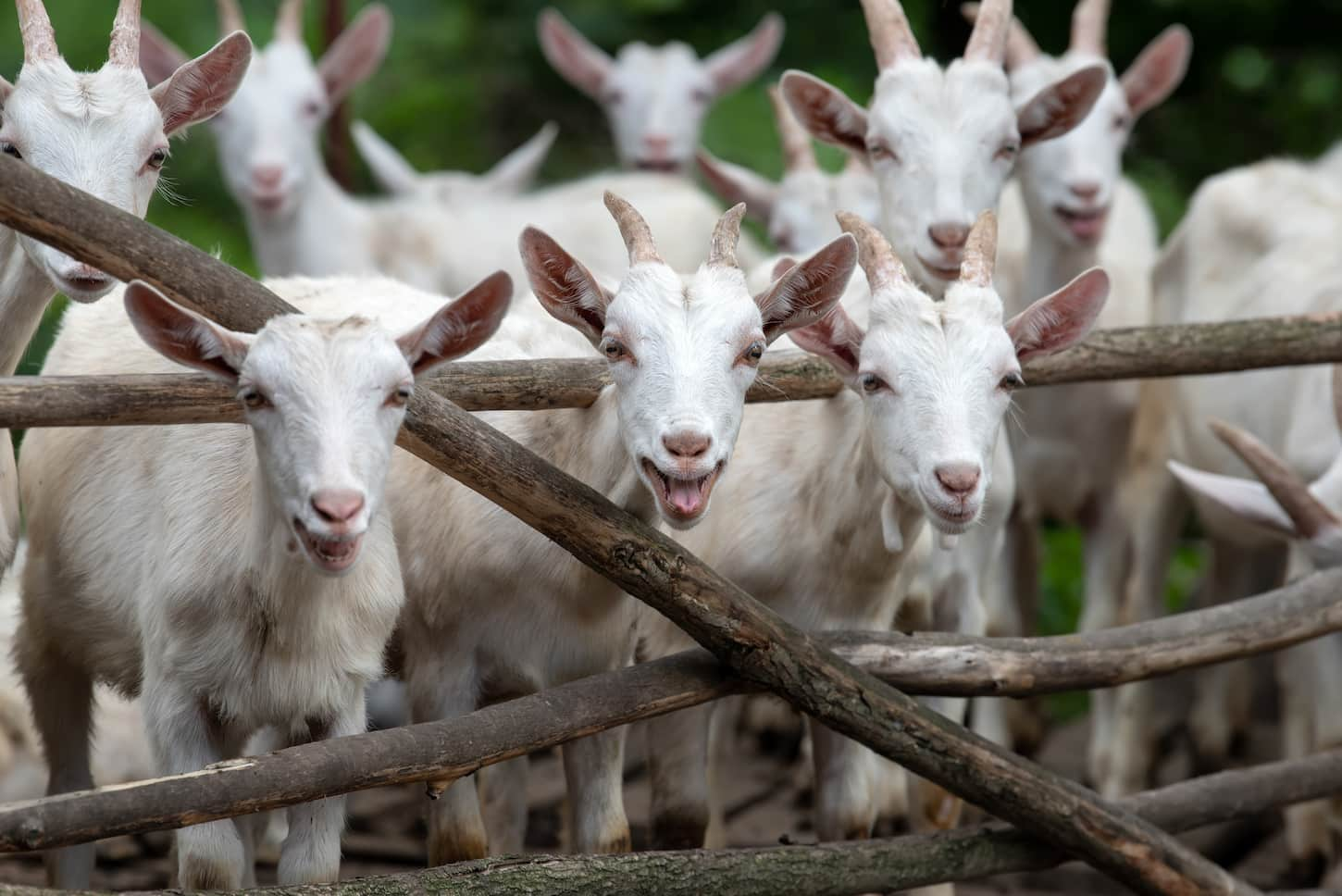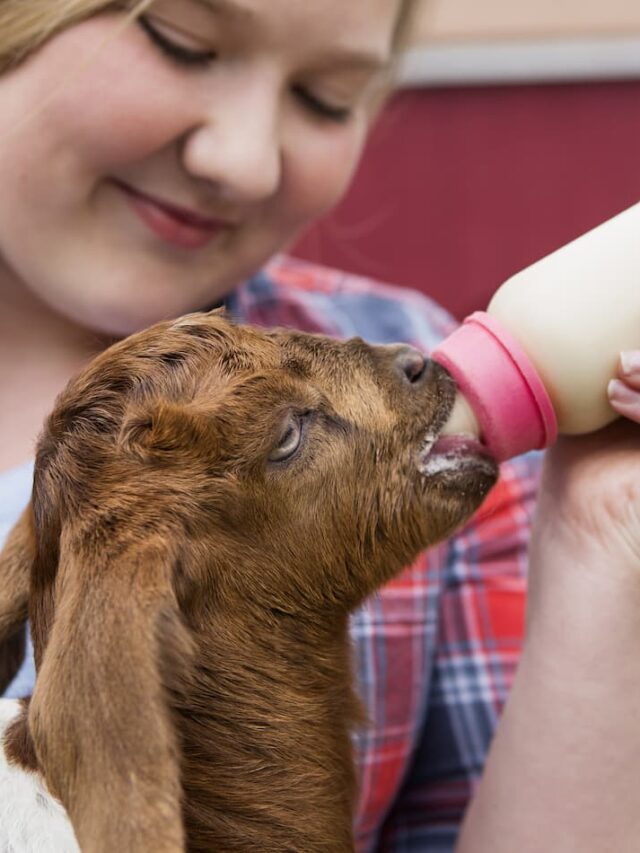Baby goats are pretty quick developers. And they’ll be nibbling away at solid foods from around two weeks old. As they grow, they’ll start eating more and more solids and drinking less milk. Eventually, they won’t need their mother’s milk anymore. And this transition from milk to solids is known as weaning.
Goats will wean themselves and their kids eventually. The doe (mother goat) knows when kids are strong enough to transition to roughage, and she’ll shove kids away to wean when the time’s right. In some cases, though, a doe will let kids nurse too long, and weaning must be assisted.
In most cases, it’s not practical to let your goats wean themselves. So, if you’re breeding goats then you need to know how to wean them properly. Because weaning is one of the most stressful events in a goat’s life. So in this guide, we’ll tell you the best way to wean goats.

What is Weaning?
Weaning is when a goat kid makes the switch from milk to solid food. This is usually a gradual process, though it can be done cold turkey. Cold turkey or immediate weaning means that a kid shouldn’t have any more milk from her mother or a bottle. Often, this means separating the baby from its mother, which can be a stressful event for both animals.
Goats will naturally wean themselves and this is the least stressful weaning process for them. But sometimes this can take many months to happen – and this isn’t always practical.
For example, keeping young bucks in with their mother does after three months isn’t a great option, because the little bucklings will try to mate – even with their mother.
In most cases, if you’re breeding goats for milk or to sell them, then natural weaning that takes months past what a kid needs to be healthy isn’t the best option.
Here’s How Goats Wean Kids Naturally
When it comes to goats self-weaning naturally, the momma goat will make all of the big decisions. She’ll know when her kids are strong enough to go it alone. And when the time comes, she’ll stop the kids from drinking her milk by kicking and butting them away from her udder.
When it comes to natural weaning, each mother goat is different. Some will want the kid to stop drinking as soon as possible. While others will let their babies go on drinking for a long time. Overall there are fewer problems and less stress with natural weaning.
For a first-time freshener, though, they may not be as forceful as needed when it’s time to wean. So many first fresheners will let their kids suckle for crazy long amounts of time. If this is the case, it may be time to step in and help your does wean their kids appropriately.
What Age Can a Baby Goat Leave its Mom?
The best time for a baby goat to leave its mom while still being safe and healthy is between two and three months old, or when the baby goat has reached 2.5 to 3 times its birth weight. If a doe rejects a kid, then the baby goat will require bottle feedings and can be removed from the mom immediately.
It’s possible to wean a kid early from as young as 28 days, but to give them the best start in life it’s better to wait until they’re at least 60 days old. Weaning before 60 days is considered early weaning.
You can use both weight and age to determine the right time for weaning.
I’ve seen some studies and a ton of anecdotal evidence that show that most weaning should not be early – and that 60 days is really a good minimum for waiting to wean.

How Long Does it Take to Wean a Goat?
The act of weaning a kid, if done all at once, only takes minutes. However, the whole weaning process can take a few weeks to prepare. This is because you’ll have to get an area ready and also arrange health checks and vaccinations for the kids.
You might also want to take time familiarizing kids with a new pen in the weeks leading up to weaning. This can make the weaning day a little less stressful.
Again, the length of time it takes to wean a kid depends on whether you choose to do it all at once or to let the doe do it naturally over time. But if you do it all at one go with the vaccines? Expect a few weeks of preparation – and then it’ll all be over with pretty quickly on weaning day.
Another option is, once the kids are at least a few weeks old, to separate the kids from mom at night. This is an especially popular option for dairy goat owners so that the does can be milked in the morning while still providing enough milk for their kids during the daytime.
How Do You Wean a Goat From its Mother?
Weaning can be done either via an immediate removal from the mother or over time. A sudden change like this can be terribly stressful for goats. To make weaning as stress-less as possible, it should be done with gradual changes and gradually increased amounts of time separate. This way, weaning day will be less traumatic.
Below we’ve listed the important things you should do when it comes to weaning kids. By following these steps, you can make the experience more bearable for your goats.
Step #1: Pick a good day
Firstly, you need to pick a day for weaning and aim to have everything prepared for this date. You’ll need to supervise freshly weaned goats a lot in the first 48 hours. So make sure that you have time available on this date. The last thing you want is time pressure. This will only bring more stress to the situation.
Step #2: Prepare a separate area
You need to make sure that you have a weaning pen or field prepared for the kids. Or that you have a separate place to take the does. This is because the does and kids will have to be physically separated on weaning day.
Some breeders like to keep the kids close by to the does, so they still have a sense of connection. This might be comforting for some kids, but others might find it more distressing if they can see and hear their mom but can’t get to her.
If you’re separating does from bucklings, make sure there’s more than a flimsy wire fence between them. Bucklings can still nurse and even breed their mother through a wire fence.
This is why other owners prefer to take the does as far away as possible. So that they can’t hear each other calling. Sometimes you might not have enough space to keep a huge distance between them. So it’s good to know that both of these weaning methods are ok.
Step #3: Get the weaning pen ready
If you’re breeding goats, then it’s worth making a weaning pen. This not only helps at weaning time but it’s also useful if you ever have to confine or separate any goats or babies.
If you’re using a weaning pen then a few weeks before weaning you should let the kids spend a few hours in it each day. This way they’ll be familiar with it when the time comes for weaning.
However, you don’t have to have a weaning pen to wean goats. Some breeders like to leave the kids in their nursery pasture and remove the does instead. Thus removing a little bit of stress from weaning because the kids will stay in a familiar environment.
Step #4: Make sure the kids are healthy and eating roughage well
From around two weeks old, baby goats should be eating grass or forage. This encourages their digestive system to adapt to eating grass. As their digestive system develops they’ll gradually start eating more solid food.
This is why you must make sure that your kids are eating plenty of solid food before weaning. Because if they’re not then they might be susceptible to problems at weaning time.
One way to make sure that baby goats are eating plenty of solids is by using a creep feeder. This is a device that lets small babies eat but keeps adult goats out. You can start using a creep feeder for baby goats from around 3 weeks old.
Step #5: Reduce the does’ food rations
Around two to three weeks before weaning, you should also reduce the doe’s food rations to a non-lactating amount. This is because she no longer needs lots of nutrients to produce as much milk for the kids.
This will make her milk less nourishing which will encourage the kids to eat more solid food. And it also reduces problems with “drying off,” which is when the doe stops producing milk.
Note: if you’re planning to keep milking the does, then you may not want to reduce their rations by much (if at all), because you still want the milk.
Instead, you’ll need to rely on fences and distance to help more than this tip.
Step #6: Make sure the kids are healthy
Before weaning, you should make it standard practice to vaccinate your kids and treat them for parasites. This will put your kids in optimum health when the time comes for weaning. Kids are still developing their immune systems at this age so they can be vulnerable to parasites and diseases.
Another thing you should treat your kid for before weaning is coccidiosis, which we’ll explore later on in the article. You should speak to your vet to arrange a treatment plan for coccidiosis, vaccinations, and worming as needed before weaning.
It’s also a common practice to debud or dehorn kids at this same time.
If doing all of this on your own isn’t appealing, you can talk to your local livestock veterinarian. They may be able to help with these services or recommend a competent and experienced goat wrangler who can come manage things with (or for) you.
Step #7: Never leave a goat alone
If you have several babies to wean then it’s better to do them in groups. This is so that they won’t get lonely. If a baby goat is left alone after weaning then it will be terribly distressed. And terribly distressed goats are NOISY.
When you’re planning your baby goat groups, you must separate the young males and females – unless the bucklings (boys) are already castrated. This is because the boys might try to mate with the girls.
And you should never leave a recently weaned doe alone either. The weaning process is stressful for her too, so make sure she has at least one friend for company.

Weaning Day
When it comes to weaning day then it’s better to do it early in the morning. It’s cooler then and this also gives the kids a lot of time to settle down by nightfall. And if the weather is bad on weaning day you should put it off until there’s better weather.
And when the time comes for removing the kids or does, you can expect lots of crying and bleating. Baby goats love milk and their moms so they’re going to be upset about weaning most of the time. It’s normal for the doe to be distressed about losing her babies too.
Once they’ve been separated, you can try giving the kids a bit of food to settle them down.
Does and kids who are separated (and/or weaned) ahead of a natural weaning schedule will be loud and vocal for up to several weeks. They will be louder, more agitated, and possibly in danger if left alone.
Health Problems that Can Happen at Weaning Time
Weaning is a stressful time for both does and kids. And this stress can leave them susceptible to health problems. So you must keep a close eye on them both in the weeks following weaning. Below, we’ve outlined the two most common problems to look out for after weaning.
Problem #1: Mastitis (does only)
Mastitis is an udder infection that can affect does after weaning. It happens when the doe accumulates too much milk and it becomes toxic. This is why you must check your Doe’s udder regularly for the few weeks after weaning to make sure that she’s “drying up” properly.
Symptoms of mastitis include a large swollen udder that may be hot, red, and painful. Mastitis milk will be clotted, stringy, gooey, and foul-smelling. In severe cases, mastitis in goats can be fatal so you must call your vet if you think your goat has mastitis.
Problem #2: Coccidiosis
The main health concern with kids after weaning is coccidiosis. This is caused by an imbalance of the coccidia protozoa, which are naturally found in the digestive system of goats and kids.
During a stressful period, these protozoa will overproduce and damage the kid’s digestive system. And in worse cases, this can be fatal. Bloody scours can be an indicator of coccidiosis. However, often there are no symptoms at all.
To reduce the chances of coccidiosis, you can give your kids preventative treatment before, during, and after weaning. You should speak to your vet about preventative treatments for coccidiosis.
Coccidiosis can affect goats of all ages, but it is typically more of a problem for kids, as does have had time to build up an immunity.
If you’re ever worried about coccidiosis or its symptoms, please call your local livestock veterinarian.

How Do You Wean Bottle Fed Goats?
Weaning bottle-fed goats is a little less stressful because the kids don’t have the added anxiety of leaving their mother. However, they will still kick up a fuss about having their milk removed. So you mustn’t give in to their demands for more milk.
To wean bottle-fed kids, two to three weeks before their planned weaning date, simply reduce their milk rations. So if they’re getting two bottles a day, start giving them one and three quarters instead. And continue to reduce this gradually down to nothing.
When you’re weaning bottle-fed kids you should still vaccinate them and treat them for parasites, as you would with doe-reared kids. And make sure that they’re eating enough solid foods after weaning.
Now, if you’d like more tips on bottle-feeding kids, make sure you read my guide Baby Goat Refusing The Bottle? Here’s What to Do. It’ll help walk you through a lot of problems so that you can avoid them or make them a whole lot less problematic.
After Weaning Advice
After weaning, the mother and babies may be distressed. So below we’ve listed some things you can do after weaning to make sure your goats are safe and comfortable.
- Check the goats regularly to make sure that the kids haven’t got stuck, or damaged the fence, in an attempt to get back to their mothers.
- Make sure that they have plenty of water available and that they’re eating enough hard food and forage. It’s normal for a kid to lose a little bit of weight in the first few days after weaning due to stress, but if the weight loss continues then you should talk to your vet.
- Move the doe to regular quality pasture and reduce her food rations. This is because she no longer needs rich food. And this will reduce the chance of mastitis.
Weaning is a traumatic experience but by following the advice in this guide, you can make it a little less stressful for your goats. Make sure that you’re well prepared and that kids are a healthy weight and eating well before you wean them. And bear in mind, that even though weaning seems traumatic, the stress should be over after a day or two.
Key Takeaways
Goats are amazing creatures. They really are! And for the most part, they’ll handle all of the things on their own. Weaning is just one of those things that, as a responsible goat owner and breeder, you’ll likely have to help them with.
Because letting a buckling breed his mother? That’s a very real possibility – and not a road you want to go down without making that choice intentionally. And, really – I don’t know of any breeders who choose that. It’s generally seen as an irresponsible breeding choice in a worst-case scenario or as accidental breeding at best.
So make sure that you’re ready for breeding and weaning season – whether you plan on enjoying any of that sweet, delicious goat milk for yourself. Oh, and make sure you check out my guide on the easier, faster way to milk goats next. Save yourself the repetitive stress injuries in your wrists – it hurts! Go read that next and skip the injury.
Resources
Learning from your own experience is essential, but learning from others is also intelligent. These are the sources used in this article and our research to be more informed as homesteaders.
- “Facility Preparation for Weaning Kids – Goats.” US Department of Agriculture, 14 Aug. 2019, goats.extension.org/facility-preparation-for-weaning-kids.
- “How To Wean a Baby Goat From The Bottle.” Packgoats.Com, 19 Nov. 2020, packgoats.com/how-to-wean-a-baby-goat-from-the-bottle.
- Johnson, Kate. “When to Wean a Goat and Tips for Success.” Backyard Goats, 9 Mar. 2021, backyardgoats.iamcountryside.com/health/when-to-wean-a-goat-and-tips-for-success.
- Machen, Rick. “Creep Feeding Kid Goats.” Texas Agricultural Extension Services, Apr. 2012, agrilifecdn.tamu.edu/animalscience/files/2012/04/nutrition-creep-feeding-kid-goats.pdf.
- “Nutrition Issues at Weaning – Goats.” US Department of Agriculture, 14 Aug. 2019, goats.extension.org/nutrition-issues-at-weaning.
- “Post Weaning Management in Goats – Goats.” US Department of Agriculture, 14 Aug. 2019, goats.extension.org/post-weaning-management-in-goats.
- “Raising Goat Kids.” Purina Animal Nutrition, www.purinamills.com/goat-feed/education/detail/getting-your-kid-off-to-a-healthy-start. Accessed 8 Sept. 2021.
- Stanton, Tatiana. “Creep Feeding and Goat Herd Management Practices.” Cornell University Agricultural, goatdocs.ansci.cornell.edu/Resources/GoatArticles/Factsheets/CreepFactSheet.pdf.
- “Weaning Health Issues – Goats.” US Department of Agriculture, 14 Aug. 2019, goats.extension.org/weaning-health-issues.
- “Weaning Kids.” Tennessee Meat Goats, www.tennesseemeatgoats.com/articles2/weaningkids.html. Accessed 8 Sept. 2021.
- “Weaning Primer | Maryland Small Ruminant Page.” Mdsmallruminant, www.sheepandgoat.com/weaning. Accessed 8 Sept. 2021.
- Wisconsin State Farmer. “Six Tips to Make Weaning Less Stressful for Goat Kids.” Wisconsin State Farmer, 27 June 2018, eu.wisfarmer.com/story/news/2018/06/27/six-tips-make-weaning-less-stressful-goat-kids/707879002.